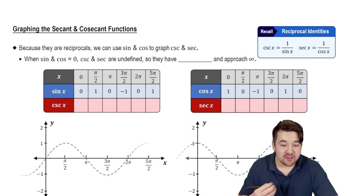Table of contents
- 0. Functions7h 52m
- Introduction to Functions16m
- Piecewise Functions10m
- Properties of Functions9m
- Common Functions1h 8m
- Transformations5m
- Combining Functions27m
- Exponent rules32m
- Exponential Functions28m
- Logarithmic Functions24m
- Properties of Logarithms34m
- Exponential & Logarithmic Equations35m
- Introduction to Trigonometric Functions38m
- Graphs of Trigonometric Functions44m
- Trigonometric Identities47m
- Inverse Trigonometric Functions48m
- 1. Limits and Continuity2h 2m
- 2. Intro to Derivatives1h 33m
- 3. Techniques of Differentiation3h 18m
- 4. Applications of Derivatives2h 38m
- 5. Graphical Applications of Derivatives6h 2m
- 6. Derivatives of Inverse, Exponential, & Logarithmic Functions2h 37m
- 7. Antiderivatives & Indefinite Integrals1h 26m
- 8. Definite Integrals4h 44m
- 9. Graphical Applications of Integrals2h 27m
- 10. Physics Applications of Integrals 2h 22m
4. Applications of Derivatives
Differentials
Problem 4.7.53
Textbook Question
17–83. Limits Evaluate the following limits. Use l’Hôpital’s Rule when it is convenient and applicable.
lim_x→0 x csc x
 Verified step by step guidance
Verified step by step guidance1
First, recognize that the limit \( \lim_{x \to 0} x \csc x \) can be rewritten using the identity \( \csc x = \frac{1}{\sin x} \). Thus, the expression becomes \( \lim_{x \to 0} \frac{x}{\sin x} \).
Observe that as \( x \to 0 \), both the numerator and the denominator approach 0, creating an indeterminate form \( \frac{0}{0} \). This is a situation where l'Hôpital's Rule can be applied.
Apply l'Hôpital's Rule, which states that for limits of the form \( \frac{0}{0} \) or \( \frac{\infty}{\infty} \), the limit \( \lim_{x \to a} \frac{f(x)}{g(x)} \) can be evaluated as \( \lim_{x \to a} \frac{f'(x)}{g'(x)} \), provided the limit on the right exists.
Differentiate the numerator \( x \) to get \( 1 \), and differentiate the denominator \( \sin x \) to get \( \cos x \). The limit now becomes \( \lim_{x \to 0} \frac{1}{\cos x} \).
Evaluate the new limit \( \lim_{x \to 0} \frac{1}{\cos x} \). Since \( \cos 0 = 1 \), the limit simplifies to \( \frac{1}{1} \).
 Verified video answer for a similar problem:
Verified video answer for a similar problem:This video solution was recommended by our tutors as helpful for the problem above
Video duration:
2mPlay a video:
Was this helpful?
Key Concepts
Here are the essential concepts you must grasp in order to answer the question correctly.
Limits
Limits are fundamental concepts in calculus that describe the behavior of a function as its input approaches a certain value. They help in understanding the function's behavior near points of interest, including points of discontinuity or where the function is not explicitly defined. Evaluating limits is crucial for defining derivatives and integrals, which are core components of calculus.
Recommended video:

One-Sided Limits
L'Hôpital's Rule
L'Hôpital's Rule is a method used to evaluate limits that result in indeterminate forms, such as 0/0 or ∞/∞. The rule states that if the limit of f(x)/g(x) leads to an indeterminate form, the limit can be found by taking the derivative of the numerator and the derivative of the denominator separately. This process can be repeated if the result remains indeterminate, making it a powerful tool for limit evaluation.
Recommended video:
Guided course

Power Rules
Cosecant Function (csc)
The cosecant function, denoted as csc(x), is the reciprocal of the sine function, defined as csc(x) = 1/sin(x). It is important in trigonometry and calculus, particularly when dealing with limits involving trigonometric functions. Understanding the behavior of csc(x) as x approaches certain values, such as 0, is essential for evaluating limits that involve this function.
Recommended video:

Graphs of Secant and Cosecant Functions







